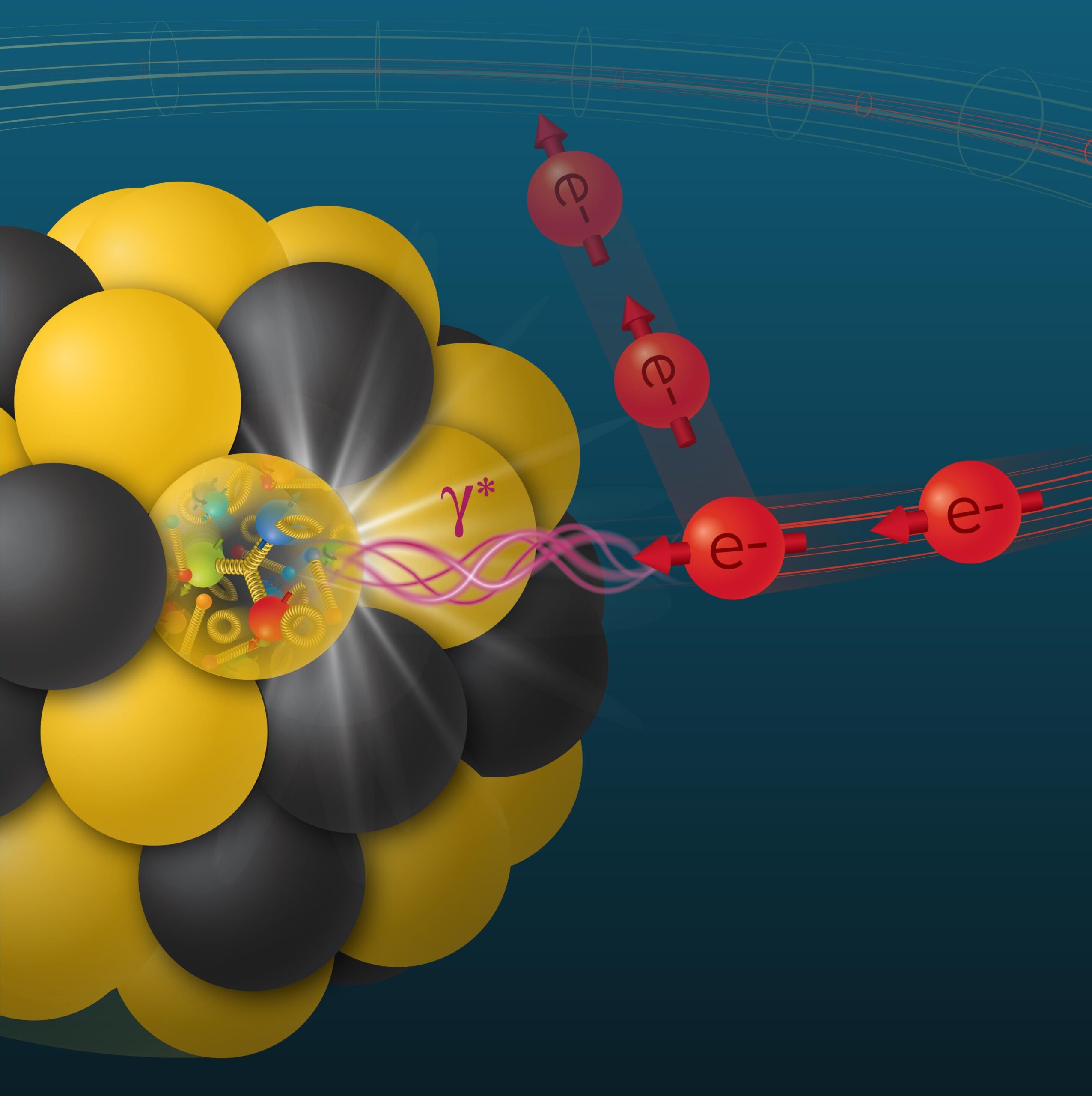Nuclear physics theorists at the U.S. Department of Energy’s (DOE) Brookhaven National Laboratory have demonstrated that complex calculations run on supercomputers can accurately predict the distribution of electric charges in mesons, particles made of a quark and an antiquark. Scientists are keen to learn more about mesons—and the whole class of particles made of quarks, collectively known as hadrons—in high-energy experiments at the future Electron-Ion Collider (EIC), a particle collider being built at Brookhaven Lab.
The predictions and measurements at the EIC will reveal how quarks and the gluons that hold them together in hadrons generate the mass and structure of nearly all visible matter.
“The fundamental science goal of the EIC is to understand how the properties of hadrons, including mesons and more familiar protons and neutrons, arise from the distributions of their constituent quarks and gluons,” said Brookhaven Lab theorist Swagato Mukherjee, who led the research.
The lightest meson, the pion, plays an essential role in the nuclear strength force, which binds protons and neutrons in atomic nuclei. By probing the mysteries of pions, protons, and other hadrons, the EIC will help scientists unravel how everything made of atoms sticks together the way it does.
The new predictions, just published in Physical Review Letters, match nicely with measurements from low-energy experiments at DOE’s Thomas Jefferson National Accelerator Facility (Jefferson Lab), Brookhaven’s partner in building the EIC, and extend into the high-energy regime planned for experiments at the new facility. These predictions are important because they will provide a basis for comparison when the EIC experiments begin in the early 2030s.
But the findings go further than establishing expectations for a single EIC measurement. As described in the paper, the scientists used their predictions—together with additional independent supercomputer calculations—to validate a widely used approach for deciphering particle properties. This approach, known as factorization, breaks complex physical processes into two components, or factors. Validation of factorization will enable many more EIC predictions and more confident interpretations of experimental results.
zAs"/>
SZC"/>
zAs"/>
Peering into hadrons
To probe the inner makeup of hadrons, the EIC will collide high-energy electrons with either protons or atomic nuclei. Virtual photons, or particles of light, emitted from the electron help reveal the properties of the hadron—sort of like a microscope for the building blocks of matter.
Collisions at the EIC will provide precise measurements of various physical scattering processes. To transform these precise measurements into high-resolution images of the building blocks of matter within hadrons, scientists rely on factorization. This theoretical approach breaks the experimental measurement—for example, the distribution of electric charges in mesons—into two components so scientists can use knowledge of two parts of the process to infer information about the third.
Think of a mathematical equation where X = Y × Z. The full value, X—the experimental measurement—can be made up of two factors, Y and Z. One factor, Y, describes how quarks and gluons are distributed inside the hadron. The other factor, Z, describes the interactions of those quarks and gluons with the high-energy virtual photon emitted by the colliding electron.
The quark/gluon distributions are very difficult to calculate because of the strong interactions between quarks and gluons inside a hadron. Those calculations contain billions of variables described by the theory of the strong interaction, known as quantum chromodynamics (QCD). Solving QCD equations typically requires simulating the interactions on an imaginary space-time lattice using powerful supercomputers.
The interactions of quarks and gluons with the virtual photon, on the other hand, are relatively weak. So, theorists can use pen-on-paper calculations to derive those values. They can then use these simple calculations combined with the experimental measurements (or predicted measurements)—and the mathematical relationship between those factors—to solve the equation and arrive at a view of the distribution of quarks and gluons inside hadrons.
“But does this actually work—separating one phenomenon into these two factors?” asked Qi Shi, a visiting graduate student in Brookhaven Lab’s Nuclear Theory Group. “We needed to prove that it does.”
To do that, the scientists ran factorization in reverse.
“We turned it around,” Shi said.
Shi and Xiang Gao, a postdoctoral researcher in the group, used supercomputers and space-time lattice simulations to calculate the quark-antiquark distributions in the mesons (Y, in the equation above). Then they used the simpler pen-on-paper calculations of the quark/gluon interactions with photons (Z) and did the math to find the predicted value for the experimental measurement (X)—the charge distribution inside mesons.
Finally, the scientists compared these new predictions with the ones they’d done using a separate supercomputer calculation—the ones that matched the Jefferson Lab measurements at low energy. By comparing the two predictions—one calculated using factorization and one computed independently using the lattice simulation approach—they could test whether factorization is a valid way to solve such problems.
The reverse factorization calculations matched their supercomputer-calculated predictions perfectly.
“In this case, we can fully compute everything using the lattice,” Shi said. “We chose this specific case because we can calculate both the left- and the right-hand sides of the equation using independent calculations to show that factorization works.”
Now, scientists can use factorization to predict and analyze other EIC observables, even when one side cannot be calculated directly.
“This work shows that the factorization approach works,” said Peter Petreczky, the group leader and a co-author of the paper. “Scientists can now make use of future EIC data and factorization to infer other more complex quark and gluon distributions in hadrons that cannot be calculated—even using the most powerful computers and sophisticated techniques.”
More information:
Heng-Tong Ding et al, QCD Predictions for Meson Electromagnetic Form Factors at High Momenta: Testing Factorization in Exclusive Processes, Physical Review Letters (2024). DOI: 10.1103/PhysRevLett.133.181902
Provided by
Brookhaven National Laboratory
Citation:
Scientists calculate predictions for meson measurements (2024, November 6)
retrieved 6 November 2024
from 7C5
This document is subject to copyright. Apart from any fair dealing for the purpose of private study or research, no
part may be reproduced without the written permission. The content is provided for information purposes only.
